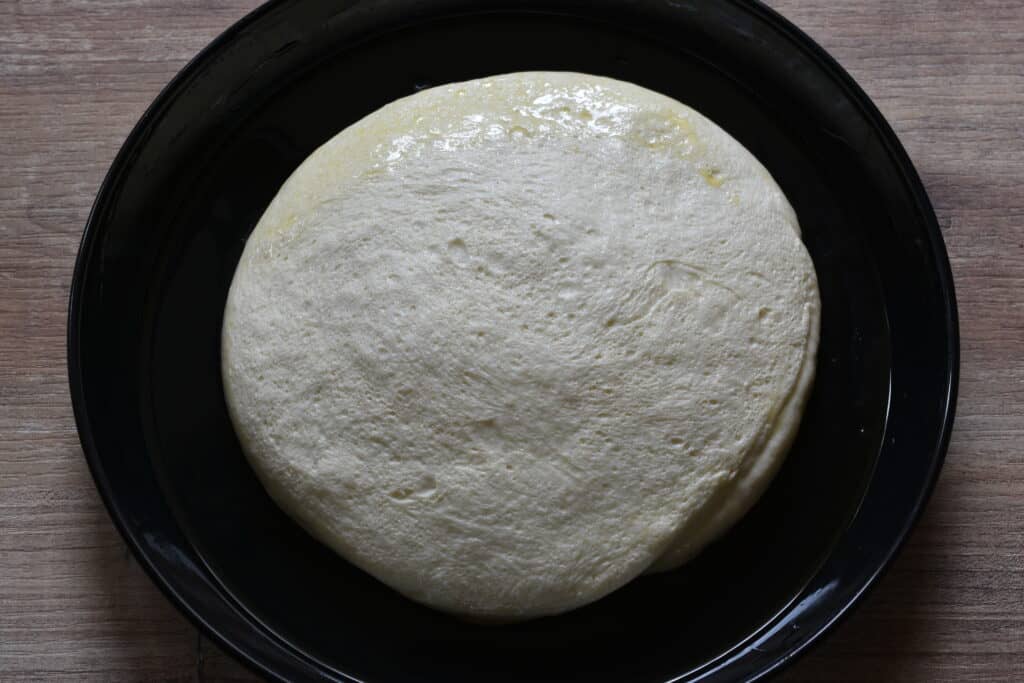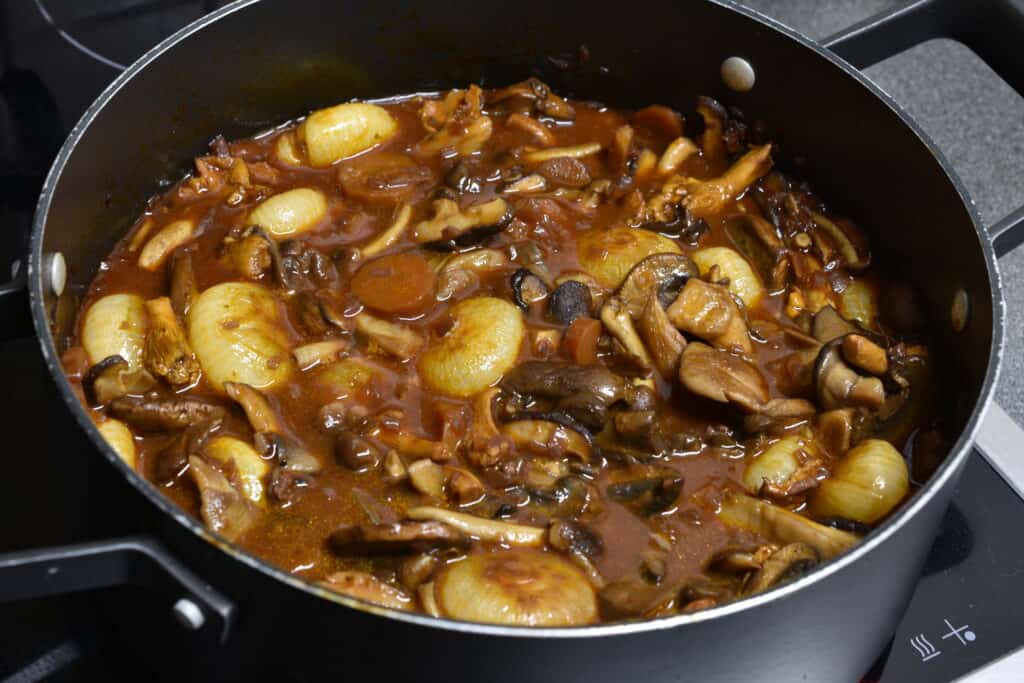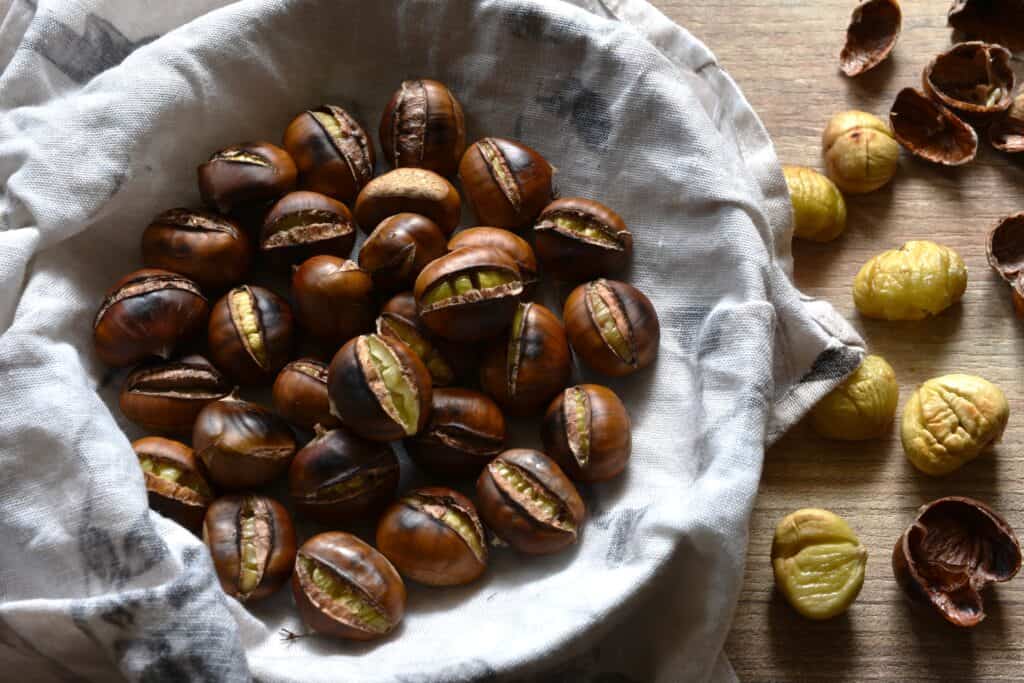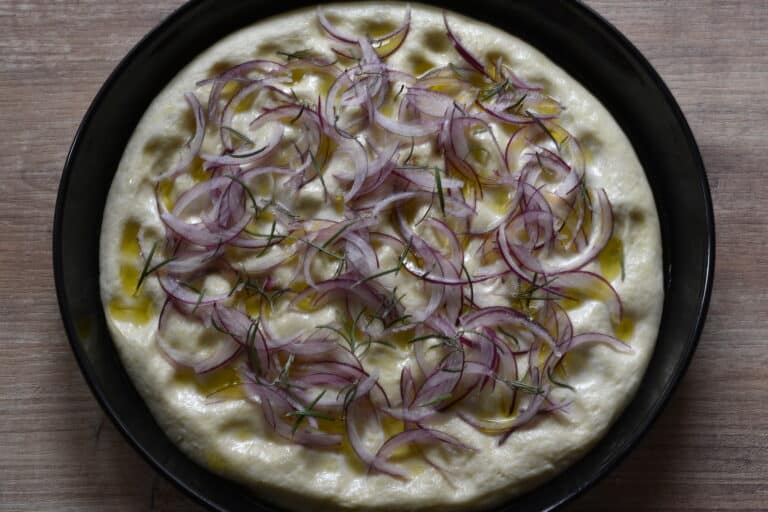This wonderfully light and fluffy Italian focaccia with red onion and rosemary is crispy on the outside and deliciously soft and moist on the inside! The well-risen internal crumb has just the right amount of tender chewiness. The scent of freshly baked focaccia is heavenly, and this one made with Italian red onions and rosemary is particularly tantalising. Known as focaccia con cipolle rosse e rosmarino in Italian, this simple but delicious bread is a way of bringing Italy’s culinary heritage into your home to share with family and good friends.
This delicious red onion and rosemary focaccia bread is perfect as an appetiser, along with a glass of Prosecco before dinner or as part of a buffet spread – it’s always one of the first things to disappear! It’s great for a picnic during the summer or as an accompaniment to a salad at lunchtime. Your hungry kids will love it as an afternoon snack! I often serve it with a plate of vegetables instead of bread. This recipe is naturally vegan and is so easy to make!
I don’t like blowing my own trumpet, but somebody has to tell you that this focaccia bread is probably one of the best you’ll ever taste. My family and friends swoon over it and say it’s the best they’ve ever had. And in this part of the world, there’s plenty of focaccia up for grabs, so let’s say they know what they’re talking about.
Where does focaccia bread originate from?
Focaccia is most commonly associated with the Italian region of Liguria, where the locals eat it throughout the day – even at breakfast time. There are other regional versions of focaccia, like focaccia barese (from the town of Bari), which is made with the addition of mashed potatoes incorporated into the dough and is typically topped with tomatoes. Then there’s focaccia di Recco which is completely different and consists of stracchino cheese sandwiched between two layers of paper-thin dough.
The most famous of all, though, is focaccia genovese, from the city of Genoa. Known as fügasse by the Genovese people, their focaccia is characterised by finger-sized holes on its surface (called ombrisalli in dialect), and it’s this recipe that I’m sharing with you today. Typical Genovese toppings include tomatoes, green olives, and onions. The most popular, however, is plain – the only flavouring being sea salt.
How to make red onion and rosemary focaccia
Important tips
There are a few things to remember when making any kind of focaccia bread.
- Firstly, allow yourself about three hours to make it because the dough needs time to rise. Very little of this time is actually hands-on time. It’ll take about 10 minutes to prepare all the ingredients and knead the dough, after which you can forget about it for a couple of hours. Then, calculate about 10 minutes to prepare the topping, get your hands in the dough to make all those characteristic little dents, and then get it in the oven.
- Secondly, bear in mind that when there aren’t many ingredients in a recipe, it’s fundamental to use quality ingredients! This applies to this focaccia, too. Only use coarse, if possible, unrefined sea salt and good quality extra virgin olive oil.
- Use the right-sized tin. The quantities stated in the recipe card below are for a 26-28 cm diameter tin. If your tin is a different size, see the note at the foot of the recipe card – you’ll find a link to a website that calculates everything for you, automatically reducing or increasing the quantities proportionally to the size of the tin you’ll be using!
- Focaccia bread has characteristic little dents in it. This effect is achieved by poking deep holes in the dough with your fingers right down to the baking sheet. Just follow my step-by-step instructions, and you’ll get it the right first time!

Ingredients
For the exact quantities of all the ingredients, see the recipe card below.
Flour
You’ll get the best results with strong bread flour. If you’ve only got all-purpose white flour, go ahead and use it. I’ve made this red onion and rosemary focaccia many times with all-purpose flour. It will result in a slightly softer and less chewy texture, but it can be a suitable option if you don’t have bread flour readily available. The higher protein content in bread flour provides better rise and oven spring, giving your focaccia a thicker, airier, and more robust texture. In Italy, you can buy flour specifically for making focaccia. It’s usually a strong bread flour mixed with a small percentage of semola rimacinata, which is a very fine type of semolina flour. I usually use either that or strong bread flour.
Salt
For focaccia, you’ll need fine salt for the dough and some coarse salt, if possible unrefined sea salt, for sprinkling on the top.
Water
Use water that is no more than lukewarm. If it’s too warm, it will kill the yeast. The temperature is right when it feels neither warm nor cool on your skin.
Yeast
You’ll need fresh yeast for this recipe. If you prefer to use dried yeast, see the note at the foot of the recipe card – there, you’ll find a link for the conversion.
Sugar
The small amount of sugar in this recipe is to provide a source of nourishment for the yeast in the dough. Yeast is a microorganism that ferments the sugars in the dough, producing carbon dioxide, which causes the dough to rise. The addition of sugar can help activate and energize the yeast more quickly, resulting in a faster and more reliable rise.
Oil
There is a lot of oil in focaccia – probably way more than you think fit (and you’re probably right – at least from a health point of view). If you squeeze some Ligurian focaccia, they literally ooze oil. I don’t recommend changing the quantity of oil in the dough. If you want, you can cut down on the amount you drizzle over the top. In any case, use a good quality extra virgin olive oil.
Onion
I used red onions from Tropea. Tropea onions come from the town of the same name in the Italian region of Calabria. Tropea is famous for its onions, as well as its charming historic centre and spectacular beaches. You can use any kind of red onion or even yellow onion for this recipe.
Rosemary
You can use either fresh or dried rosemary on this focaccia

Method – How to make focaccia dough
In the recipe card below, you’ll find easy step-by-step instructions with photos.
Focaccia dough is surprisingly simple to make.
- First of all, sift the flour and salt into a bowl and set aside.
- Measure or weigh the water and make sure that it is only lukewarm before pouring it into a jug and adding the fresh yeast and sugar. You can help the yeast to dissolve by putting your fingers in the jug and mixing it with your fingertips.
- Once the yeast has dissolved, pour it into the bowl with the flour and salt. Then, add the oil.
- Mix the ingredients by hand, with a spatula, or in an electric dough mixer until the dough comes together. If you have weighed your ingredients precisely, your dough should be perfect!
What to do if your dough is too dry or too wet
- Allow the dough time to come together properly. It should be slightly sticky but workable. It is possible that one particular flour has slightly different water-absorbing properties from another. If it really is too dry, add a teaspoon of water at a time until you reach the right consistency. When the dough is of the correct consistency, it will stick very slightly to your hands. If the dough is excessively wet, add a teaspoon of flour and knead it in well before adding any more. Repeat if necessary until the dough is just right.
How to knead focaccia dough
- You can use a mixer to knead the dough or knead it by hand. Knead it for 5 to 10 minutes until the dough is smooth and elastic.
First dough rise
- Grease a bowl with a tablespoon of olive oil. The bowl you used for mixing the ingredients is fine. Put the ball of dough in the bottom of the bowl. The oil will prevent it from sticking. Cover the bowl with a silicone lid or cling film to prevent the dough from drying out on top. Leave it in a warm place for an hour or two until the dough has at least doubled in size.
- The dough will rise better in a warm place. In summer, room temperature is just fine. In winter, you could place it near a radiator or in front of a sunny window. Otherwise, you could turn on your oven for a minute so that the temperature is similar to that of a warm room. Don’t forget to turn it off again straightaway, though, before you put the dough in! After an hour, your dough should have risen considerably. Leave it a little longer if necessary. The time it takes depends on the ambient temperature.
- Carry out the poke test: Gently press your fingertip (lightly floured) into the dough about half an inch deep. If the indentation springs back slowly but not completely, the dough is likely adequately proofed. On the other hand, If it springs back quickly, it needs more time. If it doesn’t spring back at all and the indentation remains, it may have overproofed. Be vigilant, and don’t allow the dough to overproof. If it does, bake it anyway.

Second dough rise
- Grease a round baking tray with some olive oil. Turn the bowl upside down and tip the dough directly onto the greased baking sheet. A quick shake will free it from the bottom of the bowl.

- Carefully spread the dough out with your fingertips until it uniformly fills the tray. Try not to flatten it or knock the air bubbles out of it. A gentle movement of the fingertips from the centre outwards will do the job! Cover with cling film again and let the dough continue to rise for another 20 minutes.
How to bake red onion and rosemary focaccia
- Preheat the oven to 210 °C.
- Crush some coarse, unrefined sea salt with a mortar and pestle or with the back of a spoon.
- Uncover the dough and wet your fingertips. Use your fingers to poke deep dents all the way down to the bottom of the baking tray. You can do this in a pattern or randomly. I use all my fingers but not my thumbs.
- Mix about 2 tablespoons of extra virgin olive oil and 1 tablespoon of water in a cup. Drizzle the mixture all over the focaccia, filling the dents. If necessary, use your fingertips to gently spread it all over the surface.
- Thinly slice the onions and sprinkle them all over the focaccia.
- Add the rosemary. Use it liberally because roasting mellows the sharpness of fresh rosemary, making it slightly less pungent.
- Sprinkle with the crushed coarse sea salt.

- Put the focaccia onto a very hot tray (solid tray, not a rack) and place the tray in the centre of the oven.
- Bake for approx. 20 minutes or until the focaccia is slightly golden and cooked through.
- Remove from the oven and drizzle some more extra virgin olive oil all over the focaccia.
How to serve Red onion and rosemary focaccia
Leave your focaccia to stand for 5 minutes before trying to cut it. Then, slice it and serve it warm or cold. Red onion and rosemary focaccia is great as an appetiser with a glass of prosecco or your favourite wine. Take it on a picnic or to the beach. Kids adore it – give it to them as a snack. Serve it with vegetables, salad or soup instead of bread. It’s also immensely popular on a buffet table where people can use it to mop up dips and eat with grilled or roasted vegetables and lots of other things.

How to store red onion and rosemary focaccia
I seriously doubt that you’ll have any leftovers, but if you want to keep some for another day, put it in an airtight container in the fridge where it will keep for 3 – 4 days. You can also freeze focaccia – it will keep well for a couple of weeks in a domestic freezer. Of course, technically, it is possible to freeze it for much longer, but I find that bread and focaccia don’t keep well for long periods in the freezer. Baking products tend to suffer from freezer burn, which ultimately changes the texture of the food.
If you like this recipe for red onion and rosemary focaccia, I’d really appreciate it if you could rate it and leave a comment! It helps me immensely, and it also helps others discover my blog and recipes. Thank you for supporting Vegan Hot Stuff! Deborah xxx
While you’re here, maybe you’d like to take a look at some other popular autumn recipes!






Subscribe below to receive more vegan recipes as soon as I publish them!











Wow! This recipe is one of the easiest focaccia recipes I have ever tried! Simple AND delicious.
10/10
Thanks for the great review! I’m really glad you liked it.